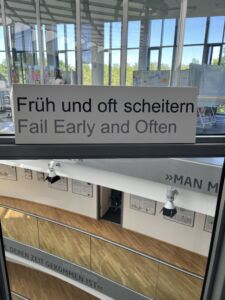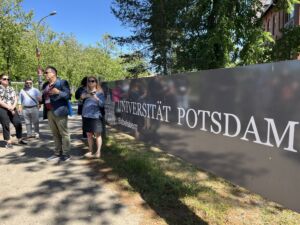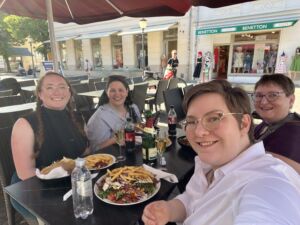Lost (and Found) in Transition
Potsdam is a place between, where East and West Germany were divided between American and Soviet forces in the year following WWII. This history is reflected in the architecture of its buildings and its people. Neoclassic facades, many reconstructed after the city was bombed by both America and the Soviet Union just months before the war ended, mingle with communist-era brutalist mid-rise hotels.

Presentation at the ZZF Leibniz Institute for Contemporary History
NAFAns had an opportunity to explore this liminal space at the ZZF Leibniz Institute for Contemporary History. Originally an East German research institute, in 1992 it was reimagined as an opportunity for researchers from across the newly unified nation to study GDR history together. Today, this world-renowned institute supports nearly 100 research faculty and fellows in areas such as Contemporary History and History of Transition.

Plaque at the Hasso Plattno Institute, which emphasizes the importance of design thinking
Similarly at the Hasso Plattner Institute (HPI) at the University of Potsdam, a history of humanities-centric education meets digital transformation in a hybrid research/academic institution. Students there are tasked with leading the transition of Germany from an analog society (fax machines are alive and well here) to a technological leading light. In opening their programs to the world, there is tension between the desire to preserve German-language programs and the practicality of English as a language of instruction for an increasingly international student body.

NAFAns at the University of Potsdam
All these transitions were on my mind when two of us got separated from the group on the way from ZZF to the University of Potsdam and had to make our way across the city with only a vague idea as to our destination. Thankfully after walking for far longer than the anticipated 10 minutes, we reconnected with part of the group for lunch. In getting lost on the cobblestone streets, it made me think about transitions, and what is lost and what we choose to retain through periods of change.
As fellowships advisors, it’s part of our job to help applicants navigate these kinds of transitions, in the space between interest and submission. We talk a lot about the value of the process and how students grow along the way. But sometimes things get lost in the process too – how do we decide which values to hold onto and which to let fade? Germany, only 30 years removed from unity, lives with this every day. Institutions in the former East are working to redevelop relationships with US institutions which were lost under communist rule. Buildings with painful histories now house institutes of tolerance and learning. History is contextualized and memorialized every day as Germany decides how to shape its future.

Doner kebab dinner in Potsdam
There is value in getting lost. For those wanting to wrestle with life’s philosophical complexities, Germany is the perfect place to get lost – and maybe found – in transition.
Written by Heidi Bretz

